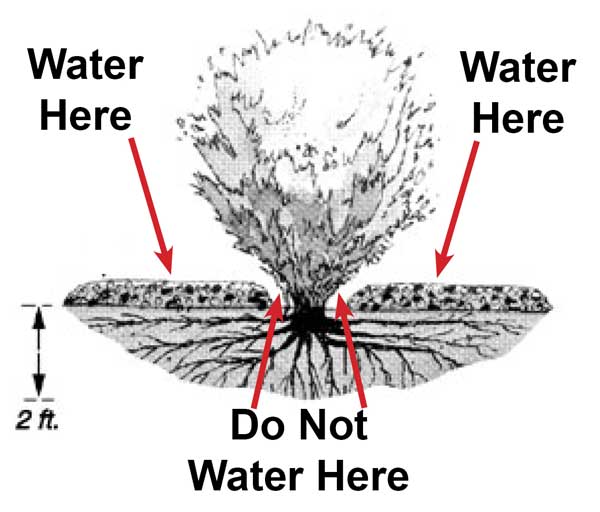Watering your plants is perhaps the most important practice of any gardener! Especially over the summer when temperatures rise and droughts occur, many plants require daily watering to stay healthy and to thrive. Regardless of what kind of plant you’re watering, always remember to water the roots! Watering the foliage of a plant will do little but accumulate fungi and diseases; plants can only absorb adequate moisture through their roots.
Plants in containers need more water than those in the ground because of their restricted growth. In addition, plants that are exposed to more sun than others will require more water. Whether you have hanging baskets, window boxes, or potted plant arrangements, they all require a thorough watering at least once a day during the heat of the summer. It’s important to check the moisture of the soil in your plant arrangements twice daily. If you stick your finger in the soil a few inches and it’s dry, give it a drink! It’s best for the plants if you water in the morning and/or at night. When dealing with potted plants, they need at least enough water to drain through the bottom of the container. You should pour water into the plant one to three times per watering so they can absorb as much moisture as possible. Using moisture control potting soil can help your plants retain more water through the driest parts of the year. Houseplants usually don't require as much water as your flowering annuals. Most established houseplants prefer a week or so between waterings.
It’s also important to keep consistent watering habits with your plants in the ground. All newly-installed plants should be watered three to four times a week, if not daily, depending on weather conditions. During their first summer in the ground, check the soil around your plants often to see if it is dry. Using mulch or stone to line your garden beds can help with moisture retention and provide other benefits as well. When watering your landscape plants remember that the bigger the plant, the more water it needs, and the smaller the plant, the more frequently it will need water. For example, if you’ve just planted a fifteen-foot tall tree it will require a larger amount of water per watering than a small perennial, but the perennial needs water more frequently because its roots are so small. If you don’t have an irrigation system or hate dragging a hose around the yard, use watering cans or watering bags. It’s the best way to deliver a designated amount of water directly to the roots of your plants! By adding organic matter like Bumper Crop or manure to the soil, you can greatly improve the water retention of the soil around your plants.

Sprinklers do not provide deep enough watering for anything other than grass. Sprinkler systems are wonderful for your lawn but they don't deliver the deep watering necessary for perennials, shrubs, and trees.
Use the following as a guideline for watering plants for their first two to three weeks (at least) in the ground *:
* When watering plants in the ground let the water settle into the soil several times during your watering so it doesn't go to waste and run off the surface.
After the first two to three weeks you may be able to decrease your watering to two or three times a week. After the first year established plants should receive a thorough watering weekly during dry spells.
Signs of over and under-watering can be very similar in most plants. Leaves will become discolored and wilted. Flowers may refuse to open or cease to form. Some trees and shrubs can completely defoliate in response to too much water or a lack thereof. Don’t panic! Plants are more resilient than we give them credit for. Most established plants can recover from defoliation and even regrow their foliage by the end of the growing season. It’s essential to examine your plants throughout the year and address any issues before they arise or soon after they occur. Symptoms of over and under-watering may be very similar, but the obvious difference will be the moisture content of the soil. By sticking your finger in the top couple inches of soil you can determine whether the plant needs water or time to dry out. Over-watered plants can accumulate mold and fungus on the foliage. Their leaves can turn brown and feel soggy to the touch. The leaves of under-watered plants, on the other hand, are crispy and crumble easily. Evergreen plants won’t show signs of stress until weeks after their issues arise. Keep a close watch on new plants, as their first year in the ground can be the most important for continued success.
If you ever have any watering questions be sure to consult our team at 860-872-7291 or info@gardenbarn.com.